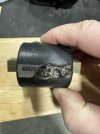- Joined
- Mar 15, 2016
- Messages
- 4,898
- Display Name
Display name:
Ari
I had to cancel a trip today because of a failed magneto. Shame on me for not doing post-flight magneto checks so I might have caught it before we played musical airplanes in 25-knot winds today. During my runup, turning off the left magneto on that engine caused no RPM drop, while turning off the right magneto caused the engine to quit. So it's not firing any of the plugs. It could be a shorted P-lead, which I plan to rule out with my digital multimeter tomorrow. (Resistance between the P-lead and ground connections on the magneto.)
While I am waiting for my A&P to get eyes on it, I want to minimize my downtime if possible. If the problem is not a shorted P-lead, is there any reason not to just order the Slick 500-hour inspection parts kit? Could it be something not included in that kit? Could it be something easily obtained outside of the kit for a fraction of the kit price?
While I am waiting for my A&P to get eyes on it, I want to minimize my downtime if possible. If the problem is not a shorted P-lead, is there any reason not to just order the Slick 500-hour inspection parts kit? Could it be something not included in that kit? Could it be something easily obtained outside of the kit for a fraction of the kit price?

